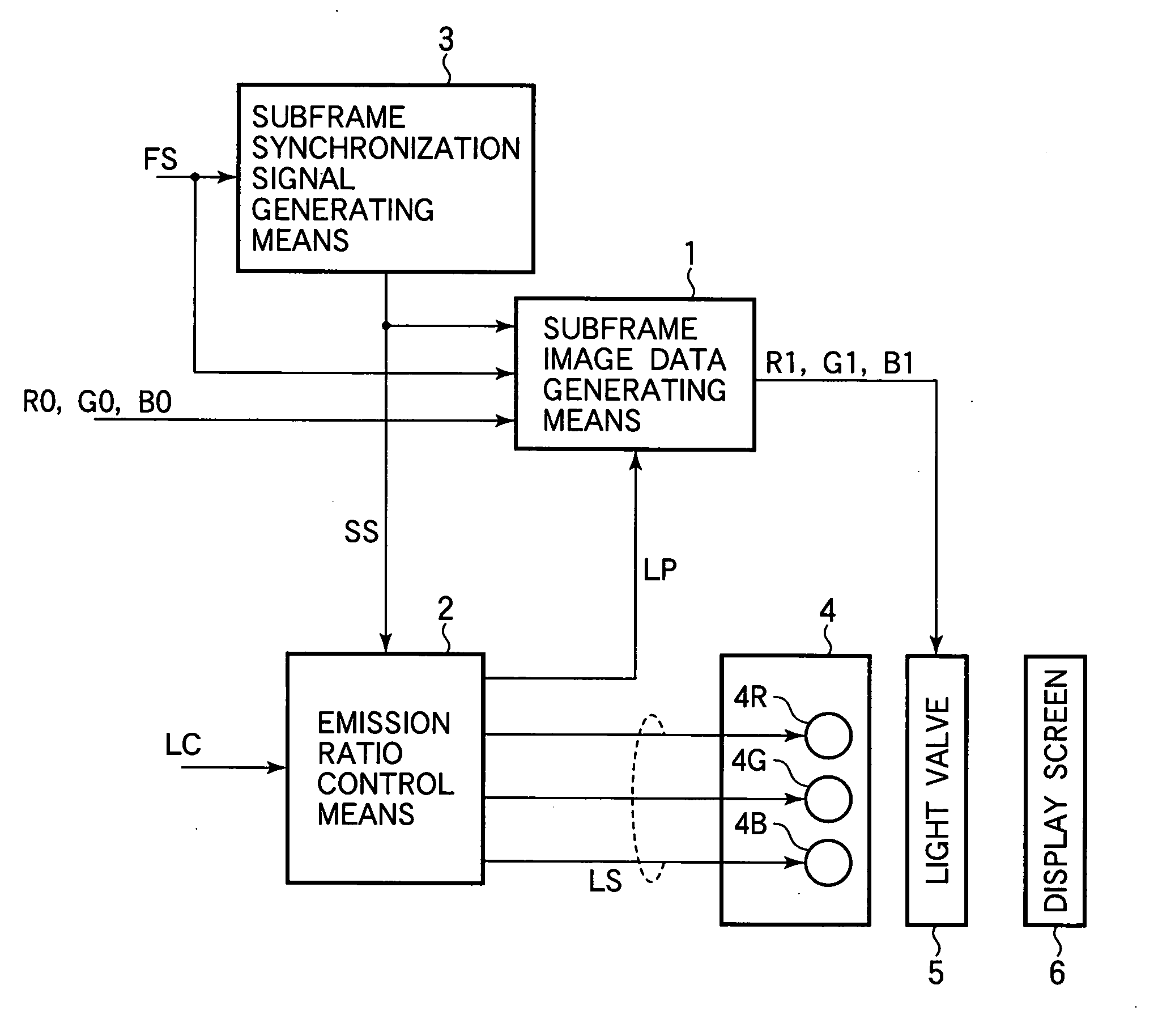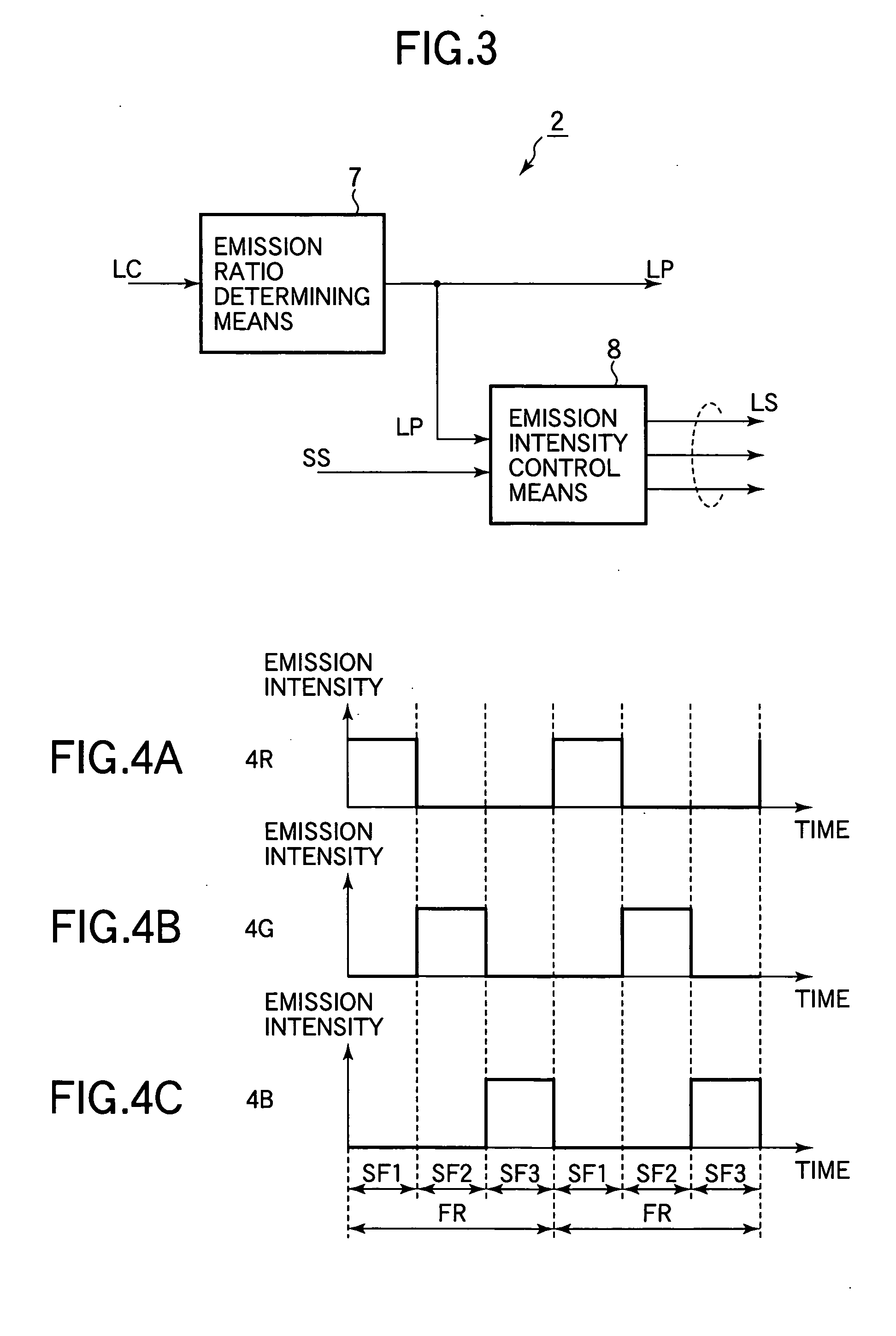Image display apparatus
a technology of image display and apparatus, applied in the direction of instruments, static indicating devices, etc., can solve the problems of unsatisfactory apparatuses when high brightness, raise size and cost problems, and apparatuses that cannot take advantage of the characteristics of input image data, or adjust optimally to ambient conditions
- Summary
- Abstract
- Description
- Claims
- Application Information
AI Technical Summary
Benefits of technology
Problems solved by technology
Method used
Image
Examples
first embodiment
[0035] Referring to FIG. 1, the first embodiment is an image display apparatus comprising a subframe image data generating means 1, an emission ratio control means 2, a subframe synchronization signal generating means 3, a light source 4, and a light valve 5. The light source 4 comprises three light emitters 4R, 4G, 4B.
[0036] The image display apparatus receives input image data R0, G0, B0, control information LC, and a frame synchronization signal FS. The frame synchronization signal FS indicates the start of each frame of the image. The input image data R0, G0, B0 indicate the magnitudes of the red, green, and blue components of each pixel in each frame. The control information LC is derived from characteristics of the input image data or conditions under which the image display apparatus is used. The emission ratio control means 2 uses the control information LC to control the emission intensities of the light emitters 4R, 4G, 4B.
[0037] The subframe synchronization signal gener...
second embodiment
[0049] Referring to FIG. 11, the second embodiment is an image display apparatus comprising a subframe image data generating means 1, an emission ratio control means 2, a subframe synchronization signal generating means 3, a light source 4, a light valve 5, and a characterizing information detection means 16. The light source 4 comprises three light emitters 4R, 4G, 4B. The image display apparatus in the second embodiment uses characterizing information or data CH output from the characterizing information detection means 16 as the control information LC which is input to the emission ratio control means 2. The characterizing information detection means 16 generates the characterizing information CH by analyzing the input image data. The characterizing information CH indicates, for example, the distribution of pixel saturation or brightness values.
[0050] The characterizing information detection means 16 shown in FIG. 12 comprises a saturation calculation means 17, a maximum value d...
third embodiment
[0064] Referring to FIG. 20, the third embodiment is an image display apparatus comprising a subframe image data generating means 1, an emission ratio control means 2, a subframe synchronization signal generating means 3, a light source 4, a light valve 5, and a usage condition specification means 28. The light source 4 comprises three light emitters 4R, 4G, 4B. The image display apparatus of the present embodiment employs usage condition data UC output from the usage condition specification means 28 as the control information LC input to the emission ratio control means 2. The usage condition specification means 28 is used by the user to specify conditions of usage, and outputs the specified results as the usage condition data UC. The usage conditions specified by the user may include, for example, the purpose of use and the usage environment. FIG. 21 shows an exemplary graphical user interface (GUI) in the usage condition specification means 28. The interface in FIG. 21 has menu b...
PUM
 Login to View More
Login to View More Abstract
Description
Claims
Application Information
 Login to View More
Login to View More - R&D
- Intellectual Property
- Life Sciences
- Materials
- Tech Scout
- Unparalleled Data Quality
- Higher Quality Content
- 60% Fewer Hallucinations
Browse by: Latest US Patents, China's latest patents, Technical Efficacy Thesaurus, Application Domain, Technology Topic, Popular Technical Reports.
© 2025 PatSnap. All rights reserved.Legal|Privacy policy|Modern Slavery Act Transparency Statement|Sitemap|About US| Contact US: help@patsnap.com



